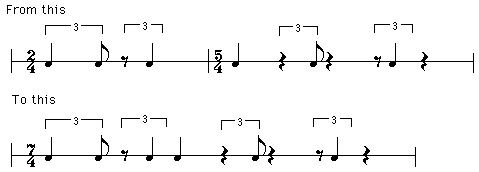About the Exercises
Why
Simply put these exercises are a way to expand the base of rhythms we use
in our playing. In practicing all the basic rhythms and their permutations
I hope to make it easier for you to execute any figure you come across or
hear in your head.
How
The exercises are in three parts.
- Play a certain rhythmic grouping (i.e. triplets or quintuplets).

Take that group and break it up into all its variations (i.e. 3 16ths
and an 8th note in a quintuplet group).

- Create polyrhythms by taking the groupings and play every other
note, every third note, etc. to create the new polyrhythm. (i.e. Every
other triplet creates a quarter note triplet)

- The on/off formula or trailing notes off of a polyrhythm. In any
grouping a certain number of notes played to a certain amount rested.

This example uses a standard sixteenth subdivision. You then proceed
to
play three of the sixteenths while resting (or flowing across) the
next
two sixteenths. Also it could be 4:5 with 2 trailing notes. This
method has no name as far as I can find. I call them " rhythm
clusters ". I would call this example 3 " A 4:5 +2 cluster
".
Notation Method
Most rhythms can be written in a variety of ways. In general I have chosen
the form that is the cleanest visually. I'm using what it is commonly
known as " drummer notation ". Drummers usually take great
liberty in the
duration of a note, they are primarily concerned with the start of an
event. Mostly because when you hit a crash or a tom you don't necessarily
know how long it's going to sustain at a given tempo. So, when you see a
quarter note followed by a rest of some sort you are free to sustain the
sound (if you have the ability on your instrument) to the beginning of the
next event. Also I use the dot in most of the exercises. Some beginners
have problems with
dots. They are extremely useful and most adopt fairly quickly. Here is an
example:

- Shows all the subdivisions clearly but its crowded and redundant.
- Cleans up the rests. Note note rest.. . looks a little better.
- Shows the cleanest version and its still easy to tell how the
rhythm is broken up while maintaining the flow. Short long. Very
hummable. :)
With the polyrhythms I chose to clearly define the underlying pulse rather
than using the notation of spanning the rhythm across beats. This way its
easier to see how the 2 rhythms flow across (or rub) each other.

Sometimes there is confusion on what the rate is for a polyrhythm. The
easiest way to think of it is when you see the ratio i.e. 3:5, 7:4, etc.,
is
to see the first number as the rate and the second number as how many
points in that rate. Therefore, 3:5 would be triplets and playing every
fifth
triplet, 7:4 would be septuplets and playing every fourth one. At some
point I
will show the shorthand on writing the polyrhythms and the concept of
using
the new rhythm as a base to expand from.
Select a comfortable tempo. One at which you can execute the grouping you
are working with.
- Learn each measure individually. Repeating until its accurate.
Note: On measures that are only a single beat. I find it easier to
count them in larger measures like 3/4 or 5/4.

- Start to combine the different measures together. You can work
systematically going from measure 1 to measure 2, 1 to 3, 1 to 4, etc.
Or you can just grab them at random.
Note: Again add up the meters. If it is a measure of 1/4 and 2/4
you
would count it as 3/4. Same for 2/4 and 5/4 adding up to 7/4.

- Use a variety of dynamics.
- Use a variety of metronome settings. From whatever the lowest is
on
your metronome (30 on mine) to as quickly as you can accurately
execute
the figures.
For specific ways to execute the exercises for different instruments see
the Possibilities page.
All the exercises have little Quicktime and/or MIDI sequences embedded in them
that play the exercises along with the original Virtual Drummer (Note: no
longer available) or original MIDI file to download. If you have this application already you are in luck. If not, over time I plan to convert them all to standard MIDI files.
For the embedded sound I choose a speed that I felt anyone should be able
to execute and that would not take forever to listen to. With the
downloadable original file you can change the tempo to anything you want,
and most importantly, you can mix and match measures to create any pattern
you want.
Each set of exercises uses the following scheme. All single and 2 beat
(1/4 and 2/4) exercises are repeated 5 times. All other multibeat
measures
(3/4, 5/4, etc. ) are repeated 3 times. There is a one measure count-in
for all exercises and etudes. You should hear a bass drum playing the
quarter note pulse, a snare drum playing the exercise, and a open triangle
playing at the beginning of each exercise.
© 1998 - 2016 Nick Marshall
Here is the official license. This will ensure the
rhythm lessons remain free. Please check out the OpenContent site for more info.
I would just like to add that if you do plan to distribute it in some form,
kindly inform me so I can let others know
(plus I'm generally curious).

Index | About | Possibilities | Feedback | Resources
| Home



![]()



